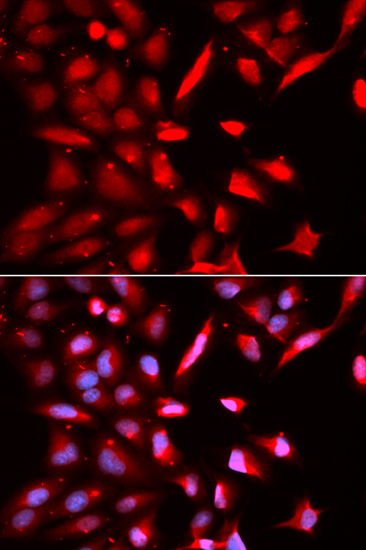PSMC3 Polyclonal Antibody
For reference only. Please follow the manual included in your kit for instructions.
Catalog Number
Product Name
PSMC3 Polyclonal Antibody
Catalog Number
RD81342A
Purification Method
Affinity purification
Isotype
IgG
Host
Rabbit
Background
The 26S proteasome is a multicatalytic proteinase complex with a highly ordered structure composed of 2 complexes, a 20S core and a 19S regulator. The 20S core is composed of 4 rings of 28 non-identical subunits; 2 rings are composed of 7 alpha subunits and 2 rings are composed of 7 beta subunits. The 19S regulator is composed of a base, which contains 6 ATPase subunits and 2 non-ATPase subunits, and a lid, which contains up to 10 non-ATPase subunits. Proteasomes are distributed throughout eukaryotic cells at a high concentration and cleave peptides in an ATP/ubiquitin-dependent process in a non-lysosomal pathway. An essential function of a modified proteasome, the immunoproteasome, is the processing of class I MHC peptides. This gene encodes one of the ATPase subunits, a member of the triple-A family of ATPases that have chaperone-like activity. This subunit may compete with PSMC2 for binding to the HIV tat protein to regulate the interaction between the viral protein and the transcription complex. A pseudogene has been identified on chromosome 9.
Immunogen Information
Immunogen
Recombinant fusion protein of human PSMC3 (NP_002799.3).
Gene ID
5702
Swissprot
P17980
Synonyms
PSMC3TBP1ATPase 3
Calculated MW
49 kDa
Observed MW
50 kDa
Applications
Reactivity
Human
Tested Applications
WB,IF
Conjugation
Unconjugated
Dilution
WB 1:500-1:2000 IF 1:50-1:200
Concentration
1 mg/mL
Storage Buffer
PBS with 0.02% sodium azide, 50% glycerol, pH7.3
Storage Instructions
Store at -20°C. Avoid freeze / thaw cycles.

